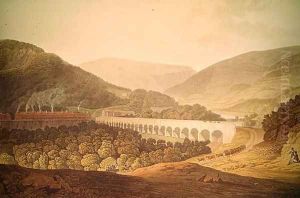Pugh, Edward Paintings
Edward Pugh was a British artist and engraver, renowned for his detailed landscapes and urban scenes, which offer a vivid glimpse into the life and environment of late 18th and early 19th century Britain. Born in 1763, Pugh's early life is not extensively documented, but it is known that he developed a keen interest in the arts at a young age. His work is characterized by a meticulous attention to detail and a keen eye for capturing the nuances of daily life, making his pieces valuable historical documents as well as works of art.
Pugh is perhaps best known for his work 'Rural Residences' (1807), a series of views of country houses in England, which showcases his skill in depicting architecture within its natural landscape. His ability to capture the essence of rural life and the beauty of the countryside endeared him to patrons and the art-loving public alike. In addition to landscapes and rural scenes, Pugh also produced cityscapes and illustrations that depicted the bustling life of urban centers, particularly of London and Chester.
His contributions to the art world extend beyond his paintings and engravings. Pugh was also an accomplished writer and illustrator. His publication 'Cambria Depicta' (1816), published posthumously, is a comprehensive portrayal of Wales, offering insights into its scenery, culture, and traditions through both text and image. This work remains a significant resource for understanding Welsh heritage and has cemented Pugh's legacy as an important figure in the documentation of British landscapes.
Edward Pugh's death in 1813 marked the loss of a talented artist whose works have continued to captivate audiences with their beauty and historical value. His dedication to portraying the British landscape has left a lasting impact on the field of art history, providing a window into the past that continues to inform and inspire. Through his paintings, engravings, and writings, Pugh has contributed significantly to the preservation of Britain's cultural and natural heritage, making him a notable figure in the annals of British art.
